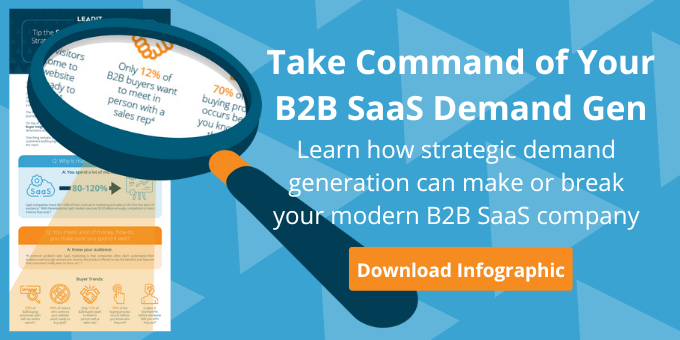
6 B2B SaaS Marketing Metrics That Really Count
A lot of marketers pay close attention to marketing metrics that measure the results of specific campaigns: clicks, opens, likes, follows, comments, and similar kinds of engagement actions.
However, these don’t always measure the bottom-line results that you expect – hope – will show up in company profits. When you report to your CMO, it’s essential that you provide numbers which help them justify the dollar value of marketing to the CEO and board of directors.
B2B SaaS company executives want stats that demonstrate how marketing is helping attract and retain customers, sell products, and ultimately increase the value of the brand.
To impress the boss, you need to measure more than individual marketing campaigns, or the collective number of impressions from all your campaigns.
Here are 6 key marketing metrics that will count with your CMO:
1. Customer Acquisition Cost Metrics (CAC)
Customer Acquisition Cost (CAC) measures the total spend required to bring in a new customer. Total CAC includes the costs of both marketing and sales.
To find CAC, calculate these numbers for a defined period:
Total sales + Total marketing costs (including salary and overhead)
# of new customers
For marketing-specific CAC, isolate your costs to marketing, then divide by the same number of new customers.
Where customers are making recurring payments or repeat purchases, the CMO may also want to know the average payback period for CAC.
To find the average CAC payback rate, divide these figures:
CAC
Average new customer monthly revenue
The result shows how many months it will take to pay back the CAC.
2. Marketing-Originated Customers (MOC)
Marketing Originated Customers (MOC) (sometimes referred to as Marketing Sourced Customers) identifies how many of your new customers have come to your brand through marketing.
To find MOC, divide these two numbers for a given period:
# of new customers generated through marketing campaigns
# of new customers from all sources
Marketing sourced leads are tracked by a campaign field on the lead record. To get this number, you can pull a report on all closed/customers in a specified time, using the campaign field as a filter to tell you what came from marketing and what didn’t.
3. Marketing-Influenced Customers (MIC)
MIC illustrates the overall reach of your brand’s marketing efforts. It includes all customers who were exposed to a marketing campaign or message, regardless of whether they were acquired through sales or marketing channels.
To find MIC, divide these two numbers:
# of new customers exposed to a marketing campaign
# of new customers
If you’re doing the calculations right, the percentage of marketing-influenced customers should be larger than the percentage of marketing-originated customers.
In order to track leads, you create content that will attract new leads. Download our eBook: 5 Tips to Build a Better B2B SaaS Brand Messaging Strategy to learn more.
4. Customer Satisfaction (CS)
Customer Satisfaction is a little less straightforward to calculate than CAC, MOC or MIC. But it may be even more important to some CMOs.
Recent trends show marketers are shifting away from traditional metrics like conversion rates, and focusing instead on metrics that represent customer satisfaction. At Leadit Marketing we actually think both metrics are important to measure and don’t think it should be an either or scenario.
To gauge customer satisfaction, survey customers. Many outsourcing firms can be found who provide this kind of survey at a reasonable cost. One of the best ways to measure this is to conduct a Net Promoter Score (NPS) Survey.
Calculate your NPS by using the answer to a key survey question, on a 0-10 scale: How likely is it that you would recommend [brand] to a friend or colleague?
Respondents are then grouped as follows:
- Promoters (score 9-10) are loyal enthusiasts who will keep buying and refer others, fueling growth.
- Passives (score 7-8) are satisfied but unenthusiastic customers who are vulnerable to competitive offerings.
- Detractors (score 0-6) are unhappy customers who can damage your brand and impede growth through negative word-of-mouth.
To find NPS, subtract these numbers:
% of Promoters – % of Detractors = NPS
This yields the Net Promoter Score, which can range from a low of -100 (if every customer is a Detractor) to a high of 100 (if every customer is a Promoter).
5. Customer Retention (CR)
Customer retention is one of the of the top 5 digital marketing metrics for success, as identified by Salesforce.
The idea is that after identifying the cost of acquiring a customer, you measure how much your company spends to retain its customers.
Having a customer marketing strategy is both a best practice, and gives you pre-built data for measuring your customer retention spend. This is an especially important metric for businesses using a subscription model.
To find your CR rate, do this calculation for a given period:
Total customers – New customers
# of customers at the start of the period
Customer retention rate can indicate whether your brand should focus more on retention vs new customer acquisition.
6. Return on Investment (ROI)
The ultimate ROI of your marketing efforts is the Big One. You may even talk about your product’s ROI in your marketing campaigns – but don’t forget it’s a measurement for yourself as well. ROI represents the bottom line value that marketing brings to your brand.
To find your ROI, divide these figures:
Profits – marketing investment
Marketing investment
The complicated part is determining how to identify your marketing investment and profits from those investments.
There are several marketing calculators and tools that can help you find your ROI. Webdam has a guide on how to measure digital asset management ROI.
View it like they do in your C-Suite
When it comes to metrics that matter, discover the stats that show a bigger picture of how your marketing is contributing to your brand’s overall value. Put yourself in your CMO’s shoes as they are called on to justify their overall marketing budget, and provide some solid proof that your efforts are bringing in results.
You want to highlight the numbers that show how you are:
- Attracting new customers,
- Improving brand sentiment among existing customers, and most important,
- Bringing in new revenue.
Many companies face specific or unusual challenges in customer acquisition. If you’d like help setting up or understanding marketing metrics for your company’s unique situation, do not hesitate to our B2B lead generation agency for a free marketing consultation.













